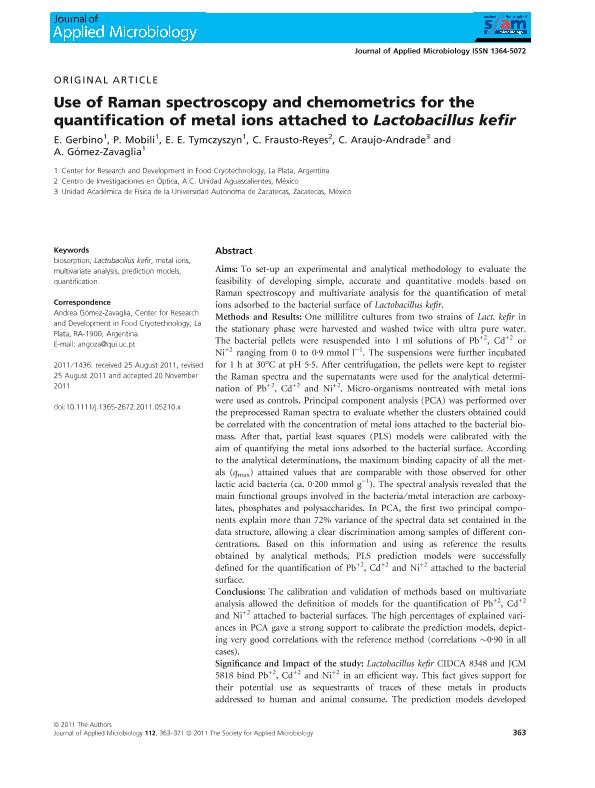Artículo
Use of Raman spectroscopy and chemometrics for the quantification of metal ions attached to Lactobacillus kefir
Gerbino, Oscar Esteban ; Mobili, Pablo
; Mobili, Pablo ; Tymczyszyn, Emma Elizabeth
; Tymczyszyn, Emma Elizabeth ; Frausto Reyes C.; Araujo Andrade C.; Gomez Zavaglia, Andrea
; Frausto Reyes C.; Araujo Andrade C.; Gomez Zavaglia, Andrea
 ; Mobili, Pablo
; Mobili, Pablo ; Tymczyszyn, Emma Elizabeth
; Tymczyszyn, Emma Elizabeth ; Frausto Reyes C.; Araujo Andrade C.; Gomez Zavaglia, Andrea
; Frausto Reyes C.; Araujo Andrade C.; Gomez Zavaglia, Andrea
Fecha de publicación:
02/2012
Editorial:
Wiley Blackwell Publishing, Inc
Revista:
Journal of Applied Microbiology
ISSN:
1364-5072
Idioma:
Inglés
Tipo de recurso:
Artículo publicado
Clasificación temática:
Resumen
Aims: To set-up an experimental and analytical methodology to evaluate the feasibility of developing simple, accurate and quantitative models based on Raman spectroscopy and multivariate analysis for the quantification of metal ions adsorbed to the bacterial surface of Lactobacillus kefir. Methods and Results: One millilitre cultures from two strains of Lact. kefir in the stationary phase were harvested and washed twice with ultra pure water. The bacterial pellets were resuspended into 1 ml solutions of Pb+2, Cd+2 or Ni+2 ranging from 0 to 0Æ9 mmol l)1 . The suspensions were further incubated for 1 h at 30C at pH 5Æ5. After centrifugation, the pellets were kept to register the Raman spectra and the supernatants were used for the analytical determination of Pb+2, Cd+2 and Ni+2. Micro-organisms nontreated with metal ions were used as controls. Principal component analysis (PCA) was performed over the preprocessed Raman spectra to evaluate whether the clusters obtained could be correlated with the concentration of metal ions attached to the bacterial biomass. After that, partial least squares (PLS) models were calibrated with the aim of quantifying the metal ions adsorbed to the bacterial surface. According to the analytical determinations, the maximum binding capacity of all the metals (qmax) attained values that are comparable with those observed for other lactic acid bacteria (ca. 0Æ200 mmol g)1 ). The spectral analysis revealed that the main functional groups involved in the bacteria ⁄ metal interaction are carboxylates, phosphates and polysaccharides. In PCA, the first two principal components explain more than 72% variance of the spectral data set contained in the data structure, allowing a clear discrimination among samples of different concentrations. Based on this information and using as reference the results obtained by analytical methods, PLS prediction models were successfully defined for the quantification of Pb+2, Cd+2 and Ni+2 attached to the bacterial surface. Conclusions: The calibration and validation of methods based on multivariate analysis allowed the definition of models for the quantification of Pb+2, Cd+2 and Ni+2 attached to bacterial surfaces. The high percentages of explained variances in PCA gave a strong support to calibrate the prediction models, depicting very good correlations with the reference method (correlations 0Æ90 in all cases). Significance and Impact of the study: Lactobacillus kefir CIDCA 8348 and JCM 5818 bind Pb+2, Cd+2 and Ni+2 in an efficient way. This fact gives support for their potential use as sequestrants of traces of these metals in products addressed to human and animal consume. The prediction models developed would be useful for the determination of the investigated metal ions in unknown samples giving at the same time, structural information about this interaction. This is certainly the most important contribution of this work.
Archivos asociados
Licencia
Identificadores
Colecciones
Articulos(CIDCA)
Articulos de CENTRO DE INV EN CRIOTECNOLOGIA DE ALIMENTOS (I)
Articulos de CENTRO DE INV EN CRIOTECNOLOGIA DE ALIMENTOS (I)
Citación
Gerbino, Oscar Esteban; Mobili, Pablo; Tymczyszyn, Emma Elizabeth; Frausto Reyes C.; Araujo Andrade C.; et al.; Use of Raman spectroscopy and chemometrics for the quantification of metal ions attached to Lactobacillus kefir; Wiley Blackwell Publishing, Inc; Journal of Applied Microbiology; 112; 2; 2-2012; 363-371
Compartir
Altmétricas



